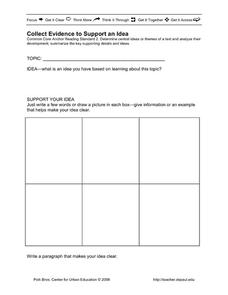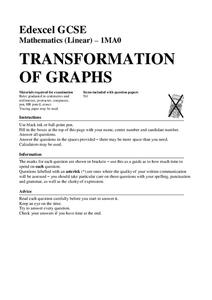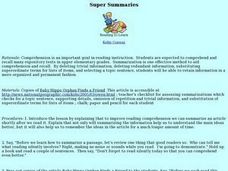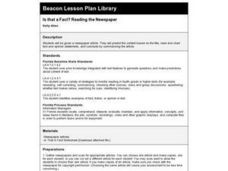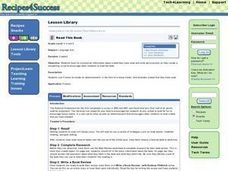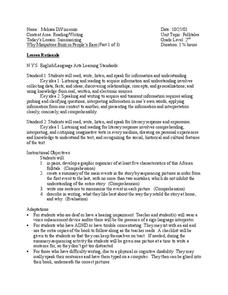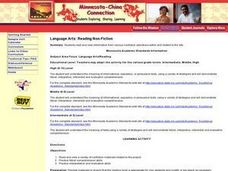Polk Bros Foundation
Collect Evidence to Support an Idea
In order to support an idea, writers must use evidence. Your class members can prepare their evidence with this basic learning exercise. Writers note down the topic they are learning about and their own idea. Next, they come up with...
Mathed Up!
Transformation of Graphs
In what ways can you transform a graph? An engaging video answers this question as it covers reflections, translations, and stretches of graphs. To test their knowledge, individuals complete a set of problems to apply this knowledge.
Curated OER
Let's Summarize!
Students discover the six steps to use when reading to help know what is important. They then listen to the book, Tambourine Moon focusing on the important information and discarding unnecessary or repeating information. They then break...
Curated OER
Fly High and Summarize
Students are introduced to the concepts of comprehension and summarizing information. They review a summerization poster which shows the information they are looking for and read a book silently. They watch the teacher model...
Curated OER
Reading to Learn
Students participate in a lesson that reinforces reading skills. Specifically, this lesson focuses on the skill of summarization. This strategy teaches students how to better comprehend written text.
Curated OER
The Long and Short of It: Summarizing Important Details
Students practice their summarizing skills while listening to a brief biography of Amelia Earhart. Students take notes while the teacher reads the article and write a paragraph that summarizes the important events from Amelia Earhart's...
Curated OER
Fun with Summarizing
Students practice summarization by creating a story map. After reading Freckle Juice, students working in groups, create a story map of the main events of the story. Groups use their story maps to summarize a chapter of the story and...
Curated OER
How to Summarize
Students review techniques on how to read a passage smoothly making the words connect, and with expression. They then read the instruction to the chapter in their science book and answer questions that are written on the board. They...
Curated OER
Predicting and Summarizing Leads to Comprehension
Students practice making predictions in order to aid in the creation of meaning when reading text. Before reading a passage, they make a prediction based on previous actions as to what will happen next in the text. Students compare and...
Curated OER
Reading the Newspaper
Learners explore how to find needed information about community events, resources, and employment. Students identify headlines, datelines, and sections of the newspaper. They participate in a newspaper treasure hunt. Learners read and...
Curated OER
Super Summaries
Third graders summarize a piece of nonfiction text. After reviewing the correct way to read in order to summarize, 3rd graders independently read a nonfiction article. They write a summary paragraph using the questions outlined by the...
Curated OER
Say W-W-W-W-Wh-at?
Students observe and demonstrate the process of summarizing text. As a class they read a paragraph and answer the five W's. Students then read an online paragraph, and complete a chart online, then in small groups write a short summary.
Curated OER
Is that a Fact? Reading the Newspaper
Fourth graders are given a newspaper article. They predict the content based on the title, read and chart fact and opinion statements, and conclude by summarizing the article. They utilize a worksheet imbedded in this plan to guide their...
Curated OER
Read This Book
Learners practice summarizing a story that they have read. They write a persuasive essay encouraging others to read the story they have finished. They are to create a movie trailer or advertisement to promote the book.
Curated OER
READING COMPREHENSION: KRISTALLNACHT
Eighth graders explore the persecution of the Jews during Hitler's leadership of Germany in 1938.
Curated OER
Why Mosquitoes Buzz in People's Ears
Second graders study folktales and their characteristics. After brainstorming what they know about Africa, 2nd graders read a book about mosquitoes. In groups, students develop a graphic organizer about the characteristics of the...
Curated OER
Science in the News
Students explore science in the news through articles, magazines, and internet news sites. They select articles, read them and summarize them to identify the audience that would care about their topics. As they present their articles...
Curated OER
Summarizing
Students analyze and summarize the main aspects of a news story. They find the "Who, What, Where, When and Why in a particular news story.In addition, they answer six questions over a particular story and then write a news story from...
Curated OER
Who in the World Is....?
Learners access how to scan the newspaper for relevant information. They become acquainted with the sections of the newspaper. Students practice summarizing what they have learned.
Curated OER
Establishing a Point of View in Narratives
Fourth graders investigate the concept and take the opportunity to both identify and to construct point of view in narratives. Additionally, 4th graders practice identifying and sequencing main events.
Curated OER
Language Arts: Reading Non-Fiction
Students read and view information sent from seven high school students who travel to China. The daily reports that they send back to the weblog section of the site should be of high interest to students in Minnesota.
Curated OER
Reading Comprehension Jobs
Students practice different strategies to aid them in drawing meaning from their reading. Students, working in groups, read an assigned text selection. Each group member provided a summary of what they have been read based on a...
Curated OER
Safety in the Biology laboratory
Students review safety in the biology laboratory. They summarize the rules and safety procedures by completing several activities such as practice questions, taking notes andbecoming familiar with the location of safety equipment.
Curated OER
Bums in the Attic
Students engage in a study about the life of young girl in the book "Bums In The Attic". They read the narrative story while considering the first person point of view. Students write a journal that analyzes the author's style of writing.
